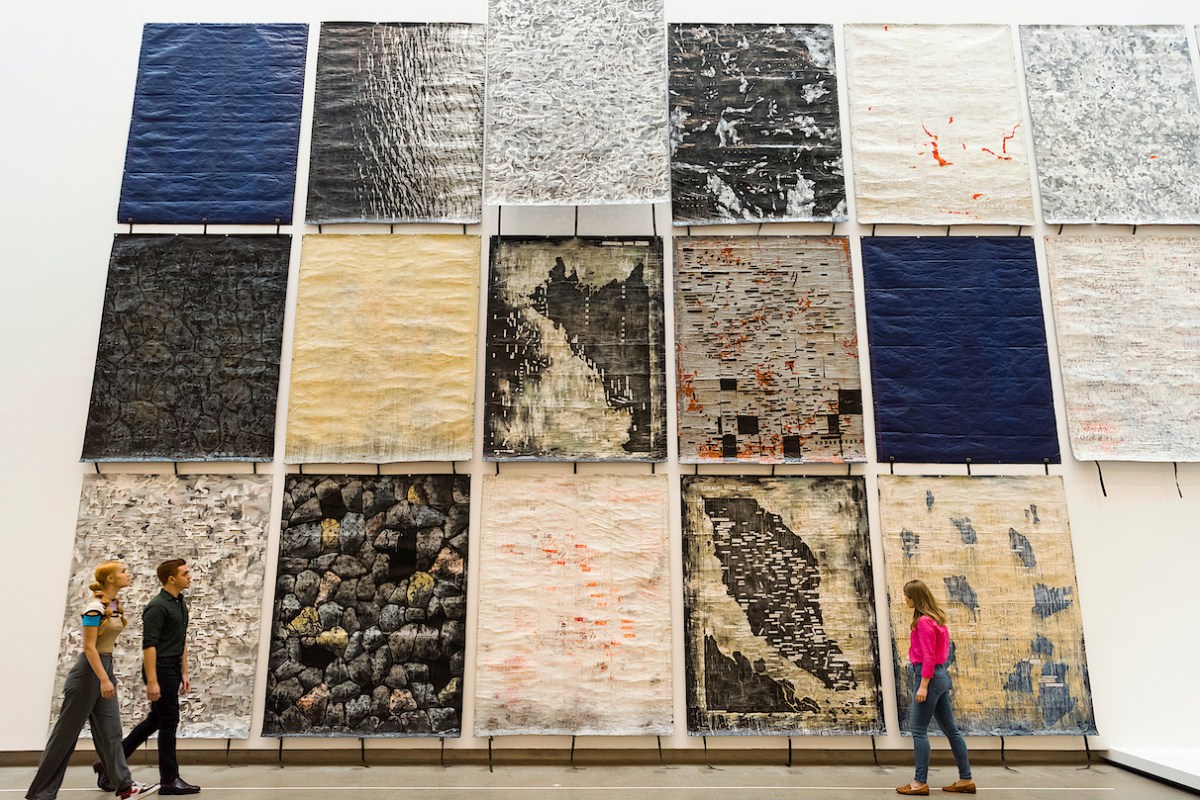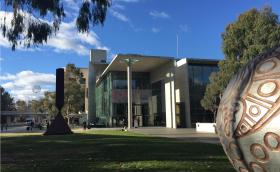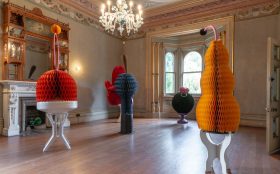It has been a long three years since the last Asia Pacific Triennial and with Covid-19’s disruptions it is a major achievement to deliver large international exhibitions at all, let alone this tenth iteration that requires significant on-the-ground research.
At Friday’s opening (December 3), surrounded by Indonesian-Australian artist Jumaadi’s narratives poetically uniting traditional folktales with imagery reflecting contemporary unrest, QAGOMA’s Head of Asian and Pacific Art, Tarun Nagesh commented: ‘APT10 has primarily been developed over the last year and a half. Most of the works in the exhibition are new. It’s a reflection about our contemporary times, as we’ve all faced uncertainty and change… Like always, artists are often the ones to unravel these new possibilities, these new re-imaginings, these new ways to see the world.’
APT has special investment in its regional community, reflecting the ideas embedded in the first exhibition in 1993 and a spirit of intellectual equality across cultures. As with Triennale iterations 1-9, APT10 is deliberately un-themed. It takes its cues from the artists and communities across the Asia Pacific region. It invites imaginative engagement in the most tactile way, taking us inside the worlds of others (some so different to our own) through a return to the hand-made, large community projects, and artists whose names are not already known.
On this front, APT10 delivers.
QAGOMA Director Chris Saines said: ‘While there is no controlling narrative guiding the curatorial hand of this, or any APT, there are really threads of common interest that emerge… There is again a strong First Nations focus with 21 of 69 projects identifying with First Nations and Indigenous peoples from Australia, Asia and the Pacific.’
‘This includes an emerging Indigenous futurism captured in a Maori worldview, ‘ka mua ka mua – we walk backwards into the future’, which is invoked in the performance and video by Shannon Te Ao,’ Saines continued.
‘And there is a focus on the collaborative community-based processes of art production found across the region with several major projects like Indigenous Uramat Identity drawing on local communities. This last group encapsulates our long-held tenet of APT, which has always respected and included the customary traditions and practices of the region, while resolutely embracing their contemporary transformations.’
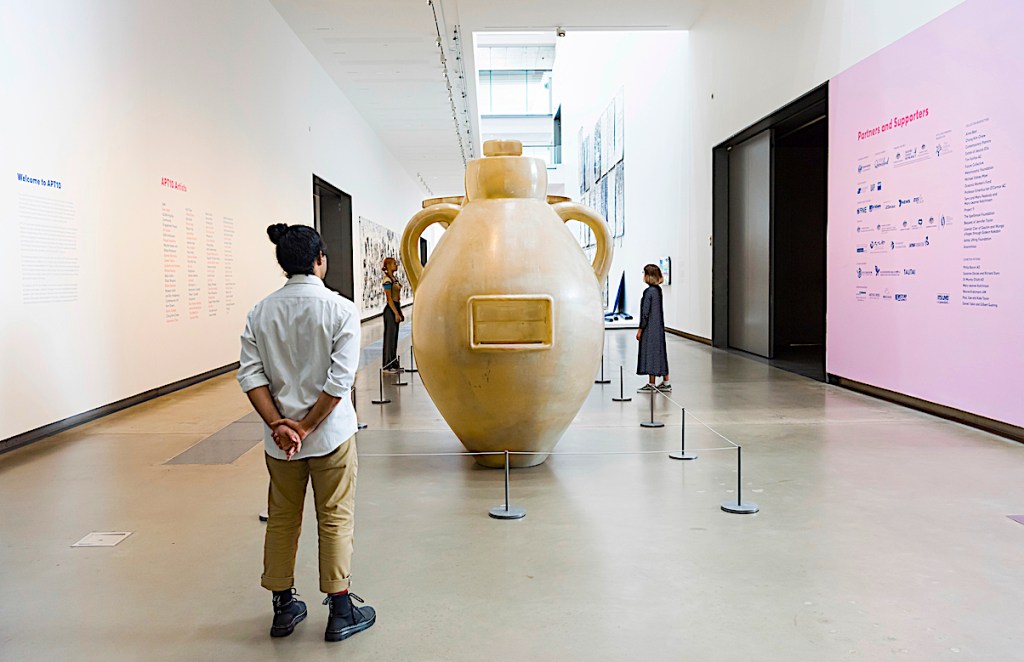
WATER, MIGRATION AND BOUNDARIES
In APT10, the exhibition is largely confined to the galleries, the cinema and the children’s art centre. At all nine of the previous events, international and national artists took large scale performances out into Brisbane’s streets and waterways, often literally.
With Queensland’s borders shut to the rest of the world at present, only four of the 150 participating artists were in Brisbane.
The choice of artists looks to the future with few of the artists included with the reputation of those who were already household names visible in previous APT’s – Yayoi Kusama (APT4), Cai Guo-Qiang (APT2 and APT3) and Montien Boonma (1953-2000) (APT1 and APT4), to mention only a few.
The reinstallation of Ai Wei Wei’s spectacular Boomerang chandelier in the Queensland Art Gallery’s Watermall (APT5) notes his rise since this work was commissioned in 2006, and gestures toward the legacy of the APT itself.
A notable APT10 exception to the trend toward the future is the well-known Kimiyo Mishima (Japan), whose highly crafted ceramic depictions of garbage speak with irony to the overwhelming scale of human overproduction.
Read: Charting a region impacted by COVID, we look at the 10th Asia Pacific Triennial
Its supersized and immersive tradition continues. In the Gallery of Modern Art’s long hall, people are dwarfed by a giant plastic water bottle and four other vessels, used to store and transport Kuwait’s precious water resources, by Alia Farid. Large drawings on rice bags by Archie Oclos, titled Immigrants of own nation (2021), depict processions of The Philippines’ displaced Indigenous peoples.
Then a series of maps on tarpaulins from Chong Kim Chiew’s Boundary fluidity series wilfully misinterpret the geographic and political topography of Malaysia and its south-east Asian neighbours. They cover the walls of this entry gallery two stories high, painted and overwritten, one peeling away, and others rolled, as portable as their boundaries and their peoples.
Between these objects and spanning some 13-metres is a makeshift raft, No location (2021) by Salote Tawale, a self-portrait of sorts that describes journeys to and within Australia, designed to negotiate climate change and the pandemic’s impacts on place and time.
Across these works, water is a touchstone, underlying its preciousness as a resource, but also as a substance that divides continents, and over which displaced people may travel.
ENGAGING THE HANDMADE
In Australia, the trade relationship that the Yolngu people shared with Indonesia’s South Sulawesi’s Macassan peoples for hundreds of years until 1906 (when these exchanges were banned) is re-nurtured in the Yolngu/Macassan project.
Collaborative hand-painted pottery, bark paintings, sails and performance celebrate this long legacy, which has remained in shared language, rituals, imagery and memory. Gunybi Ganambarr’s Djirrit (2021) situates a sailing boat mid-journey – a fresh example of the way that art may be used, as Will Stubbs writes in the catalogue, to renew ancestral connections. This project evokes the Erub/Lefou historical relationship, also rekindled through art in recent years and celebrated in APT9.
Gordon Hookey’s Murriland! (2017-2021) crystallises his historical musings about injustices visited on Aboriginal Australians, delivered with wit and power in two epic canvases. Taiwanese Indigenous futurisms are poignantly captured with explorations ranging from the personal to the political, while the Indigenous Uramat Identity’s immersive works transport visitors through day and night using sculptural ceremonial objects, sound and installation. We experience, as Ruth McDougall writes, ‘the breadth of their lived culture.’
As Nagesh pointed out, in these projects, ‘we take an in depth look at a context or an idea or a type of practice, often presenting them in ways that they have never had been presented before, or on a scale and depth that they haven’t been seen outside their region.’
Also immersive in its finely crafted delivery is India’s Mayur and Tushar Vayeda’s exploration of the spirits of the Warli, believed to live in trees, in an extensive series of beautiful paintings that traverse three sides of their gallery.
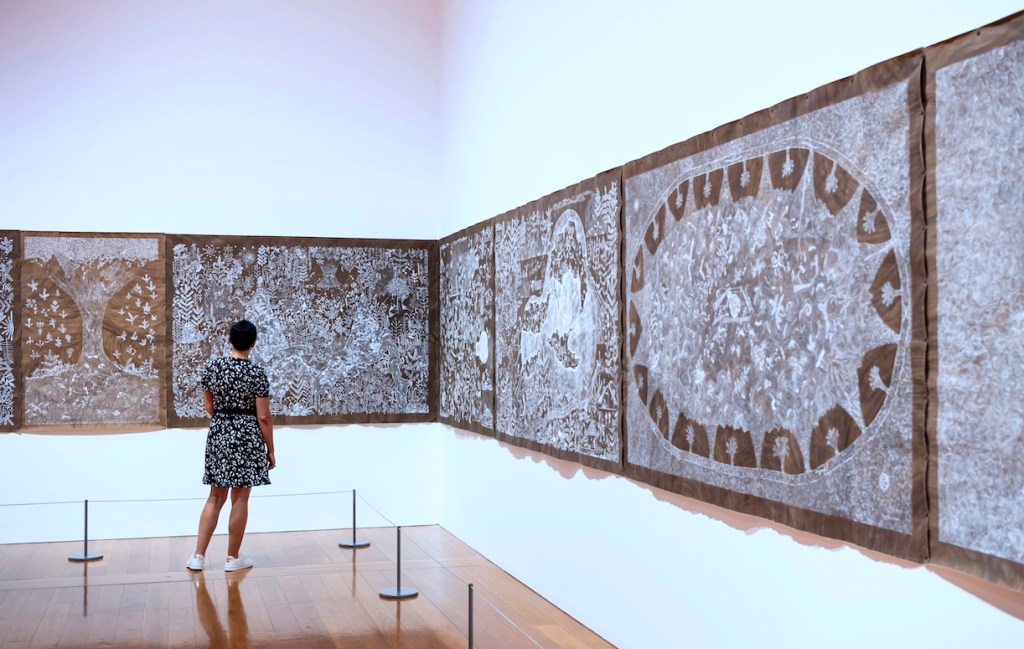
MATURE CONNECTIONS
In 1993, the first iteration of the Asia Pacific Triennial pioneered what felt like a version of contemporary art crossed with grassroots cultural diplomacy. It had a Woodstock-like sense of revolution in 1993, and required a big leap in connecting with the art of our region. The exhibition’s crafty, gritty reality had a sense of authenticity and excitement that this event has never lost.
The maturity of these now long-term connections across the region delivered APT10 even when travel was impossible.
Under Nagesh’s curatorial direction, contemporary art takes a role in ‘reimagining old cultural knowledge, old practices, reinvigorating them and revisiting them today’, alongside ‘narratives about what the future might hold, who might shape it, and various perspectives that can contribute to action towards the future.’
Saines promises an epic closing weekend in April 2022, by which time we can only hope for open borders, artists, performances and interstate and overseas visitation. The coming together inherent in APT10 and its empathetic negotiation of the region’s difficult realities offers a timely navigational salve for the future.
APT10: The 10th Asia Pacific Triennial of Contemporary Art
4 December 2021—25 April 2022
Queensland Art Gallery/Gallery of Modern Art, Brisbane
Free

